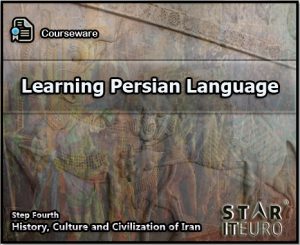
At Star IT Euro news and event page, you will find the best collection of eLearning articles, eLearning concepts and eLearning news and events.
Microsoft 365 Education Courseware
Star IT Euro produced several eLearning courseware that will provide experiences and skills to students, Teachers, Faculty and Staff with the training that they need to use the advanced software features of Microsoft Office 365 A1, (Office applications and Services), Microsoft 365 Education A3 (Office 365 A3 + Windows 10 Education A3 + Enterprise Mobility + Security E3) and Microsoft 365 Education A5 (Office 365 A5 + Windows 10 Education A5 + Enterprise Mobility + Security E5), include Office applications and Services. You can purchase these courseware from the products section.
Learning Persian Language Courseware
Star IT Euro produced several eLearning courseware that will provide experiences and skills to you on the training that you need to learning the Persian Language. This course is recommended to Persian language students in non-Persian speaking environments, new generation of Iranians outside Iran and foreigners studying in Iran. This courseware is included of the first stage of learning Persian language with title ” BASIC LESSONS “. Second stage of learning Persian language with title ” CAPITAL OF IRAN “. Third stage of learning Persian language with title ” IRAN TODAY “ and Fourth stage of learning Persian language with title ” HISTORY, CULTURE AND CIVILIZATION OF IRAN “. You can purchase these courseware from the products section.

ENTREPRENEURS ARE GREAT
Star IT Euro is now (31 July 2017) part of a unique global network – Department for International Trade’s Global Entrepreneur Programme – which is focused on supporting overseas entrepreneurs.

Star IT Euro in Birmingham Research Park
From the date February 01, 2017 Star IT Euro is as one of the companies located in Birmingham Research Park.
Microsoft Authorized Education Partner
Star IT Euro is a Microsoft Authorized Education Partner. Star IT Euro started a Authorized Education Partner from, April 01, 2016.

Microsoft Education Partner Network Member
Star IT Euro is a Network Member of the Microsoft Education Partner Network. Star IT Euro started a Microsoft Education Partner Network Member from, March 30, 2016.

Microsoft Partner Network Member
Star IT Euro is a Network Member of the Microsoft Partner Network. Star IT Euro started a Microsoft Partner Network Member from, March 24, 2016.
Focus on m-learning
iThe next two years should see a big increase in mobile learning, according to a survey by Towards Maturity which found 70% of companies planning to implement m-learning within that timescale. The report, “Mobile Learning at Work”, sponsored by Upside Learning, looks at a range of topics including: who is using it; why go mobile; overcoming barriers; benefits; challenges to implementation; and audience demographics. Using data gathered from Towards Maturity’s 2012 benchmarking survey, the report identifies trends in m-learning. It aims to help businesses to better understand how some companies are benefitting from mobile learning technologies and gives practical ideas to help them to plan an effective implementation strategy. According to the report, organisations using mobile technologies in learning are reporting more staff and business benefits than those who are not. For example 34% of mobile users report that e-learning has contributed to improvements in organisational productivity, compared to 20% of non-mobile users. Amit Garg, Director of Custom Learning Solutions at Upside Learning, said, “Mobile learning is now on the agenda of many organisations, but there is a lack of independent research and evidence in the market to help organisations plan and execute their strategies appropriately. The in–focus report offers deep insights into learning scenarios, debunking some of the myths hampering the adoption of this technology and helping organizations adopt m-learning in a way that delivers results.”
UK students want free books as they go digital
iAs tuition fees increase the UK’s “plugged-in” students expect more from their universities, including the provision of free textbooks. According to a study carried out by the NUS for Course Smart, 99% of students have at least one online device and 77% said that they use that device predominantly for academic purposes. 81% think universities should offer free textbooks as part of their fees. The study found that online devices (laptop, computer, smart phone, etc) and education appear increasingly linked in today’s university environment. 95% of students use their devices for at least some course-related reading, and 63% said that online devices help them learn better. Rachel Wenstone, vice president (higher education), NUS said: “We need to change how courses are taught to meet the needs of the 21st century student. Technology provides a good accessible way of learning and this must be balanced against the need for high quality course content and traditional delivery to provide a high quality student learning experience.” Fionnuala Duggan, managing director – International of Course Smart said: “In this environment, universities could possibly differentiate themselves by offering more connected and tech-savvy tools. For instance, offering etext books could combine the shifting demands of students with their current online habits. “Ultimately, technology and education interact in complex, fascinating ways. What is clear is that today’s students are going online – and that education needs to be there too.”
Why e-learning can under-perform
Too many companies are not getting the most out of their initial venture into e-learning. But the causes of this disappointment are preventable. Often organisations invest significant amounts of time, energy and money in developing e-learning programmes, only to find that they are not as successful as they hoped they would be with the learners. Take-up of the courses can be poor and the percentage of learners that not only start a course, but actually finish it can be low. Let’s consider the reasons behind this. When people are happy with the status quo, it can be difficult to implement change. So, for example, if learners are used to, and enjoy, going on training ‘away days,’ there may be resistance to a change in the way training is delivered. It can give rise to thoughts such as ‘I didn’t ask for this,’ and an uncooperative attitude. In addition, simply telling learners that there is an online training course available will not necessarily have them rushing to go through it. To be honest, it does not sound terribly exciting and, depending on the job function of the learner in question, at the mention of technology, some people do get decidedly nervous. All this has an impact on learner take-up. So, getting learners started can be an issue. Then, why do people who have actually started not complete the course? This is where the quality of the content comes into question. If the content is poor and not engaging, interactive or immersive, organisations should not be surprised that learners are losing interest part of the way through.
5 Ways to Demonstrate your e-Learning Success
At a recent workshop someone asked how to demonstrate that they were successful and that the courses they built made a difference to the organization. That’s a good question, especially in this economy because the training group is usually one of the first groups targeted when an organization needs to make some cuts to the budget. So we want to make sure that we’re providing real value.
E-Learning is Hot
The good thing is that right now, even with the struggling economy, e-learning is a hot industry. This makes sense. For the organization looking to make cuts and still offer training, e-learning is a viable option because it can reduce costs. It’s one of the points we discussed in this post on why e-learning is so effective. On top of that, there’s a convergence of mobile devices and remote workers. So e-learning is at the forefront of this convergence.
In that sense, if you build e-learning courses, you’re in a good industry and probably don’t need to worry about cuts as much as in the past. But let’s get back to the original question about demonstrating value.
Are Your Courses Aligned to Real Business Goals?
A common solution to meeting business goals is to offer more training. But training doesn’t always meet the organization’s goals. So it’s important to understand the organization’s goals and know where the course fits in meeting them.
Often a client wants a course but isn’t quite clear how the course actually makes a difference, other than the fact that the learner gets exposed to additional information. I always try to drill down to the expected results. After someone takes this course, what do you expect them to do? And then follow that up with, how does this relate to your organization’s goals?
An e-learning course is only a solution. Step away from the solution. Find out what the course is supposed to do and why that matters. It’s possible that you may talk the client out of an e-learning project. That’s OK. You’ll save time and money by not creating a product that’s a waste of time and that adds real value.
What Type of Course Are You Building?
I put courses into one of two buckets. Is it about information or performance?
Information courses are more like marketing programs that promote awareness with no immediate performance expectations. They can also be performance support resources. They’re important to support performance requirements but they’re not necessarily focused on performance activities.
Some people suggest that all of these types of courses should become supporting documentation rather than an “e-learning” course. That’s definitely a consideration. But with today’s tools building multimedia-based information is not any more difficult or expensive than building print documentation. So it’s just a matter or need and which solution meets it. Performance courses are focused on activities. Instead of pulling together a bunch of information, create decision-making activities that mirror the types of decisions the learner needs to make away from the courses and in the real world.
Once you understand the type of course you’re building, you can create one that offers the most value. For example, an information course may not require a lot of interactivity (which takes more time to build). And in the same sense a performance course usually needs more than dozens of bullet point screens. Understanding the type of course allows you to put your resources in a place where you get the most bang for the buck.
Are You Saving Time or Reducing Costs?
Many times you don’t have access to the types of metrics that really demonstrate the course’s effectiveness. Or you may have to build things like annual refresher training where the metrics can be a bit fuzzy. If that’s your situation, then a great way to demonstrate value is to focus on the production process and determine where you can reduce cost or save time.
– rice out the cost of your courses if you were to hire them out. Then compare those costs to yours.
– Another metric is the difference between face-to-face training and offering the same online.
You may not always be able to state what the course accomplished, but you’ll definitely be able to state that what you provided was cost-effective.
Development of custom content or enhancement of existing training programs for achieving specific learning and business objectives:
– Engaging Multimedia Courses
– Scenarios and Simulations
– Media Light Courses



